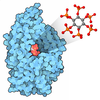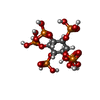[English] 日本語
 Yorodumi
Yorodumi- PDB-7pea: cryo-EM structure of DEPTOR bound to human mTOR complex 1, overal... -
+ Open data
Open data
- Basic information
Basic information
| Entry | Database: PDB / ID: 7pea | ||||||
|---|---|---|---|---|---|---|---|
| Title | cryo-EM structure of DEPTOR bound to human mTOR complex 1, overall refinement | ||||||
 Components Components |
| ||||||
 Keywords Keywords | SIGNALING PROTEIN / DEPTOR / mTOR / regulator / inhibitor / mTORC1 / DEP-domain / PDZ-domain | ||||||
| Function / homology |  Function and homology information Function and homology informationregulation of extrinsic apoptotic signaling pathway / RNA polymerase III type 2 promoter sequence-specific DNA binding / RNA polymerase III type 1 promoter sequence-specific DNA binding / positive regulation of cytoplasmic translational initiation / T-helper 1 cell lineage commitment / positive regulation of pentose-phosphate shunt / regulation of locomotor rhythm / positive regulation of wound healing, spreading of epidermal cells / TORC2 signaling / TORC2 complex ...regulation of extrinsic apoptotic signaling pathway / RNA polymerase III type 2 promoter sequence-specific DNA binding / RNA polymerase III type 1 promoter sequence-specific DNA binding / positive regulation of cytoplasmic translational initiation / T-helper 1 cell lineage commitment / positive regulation of pentose-phosphate shunt / regulation of locomotor rhythm / positive regulation of wound healing, spreading of epidermal cells / TORC2 signaling / TORC2 complex / regulation of membrane permeability / cellular response to leucine starvation / heart valve morphogenesis / negative regulation of lysosome organization / TFIIIC-class transcription factor complex binding / TORC1 complex / positive regulation of transcription of nucleolar large rRNA by RNA polymerase I / negative regulation of TORC2 signaling / calcineurin-NFAT signaling cascade / voluntary musculoskeletal movement / regulation of osteoclast differentiation / positive regulation of odontoblast differentiation / RNA polymerase III type 3 promoter sequence-specific DNA binding / positive regulation of keratinocyte migration / regulation of lysosome organization / phosphatidic acid binding / Amino acids regulate mTORC1 / cellular response to L-leucine / MTOR signalling / cellular response to nutrient / regulation of autophagosome assembly / Energy dependent regulation of mTOR by LKB1-AMPK / energy reserve metabolic process / TORC1 signaling / ruffle organization / negative regulation of cell size / cellular response to methionine / positive regulation of osteoclast differentiation / cellular response to osmotic stress / inositol hexakisphosphate binding / negative regulation of TOR signaling / protein serine/threonine kinase inhibitor activity / negative regulation of protein localization to nucleus / anoikis / enzyme-substrate adaptor activity / cardiac muscle cell development / negative regulation of calcineurin-NFAT signaling cascade / regulation of myelination / positive regulation of transcription by RNA polymerase III / regulation of cell size / positive regulation of actin filament polymerization / negative regulation of macroautophagy / Macroautophagy / positive regulation of myotube differentiation / protein kinase inhibitor activity / Constitutive Signaling by AKT1 E17K in Cancer / social behavior / oligodendrocyte differentiation / germ cell development / behavioral response to pain / TOR signaling / CD28 dependent PI3K/Akt signaling / mTORC1-mediated signalling / positive regulation of translational initiation / positive regulation of oligodendrocyte differentiation / protein kinase activator activity / positive regulation of TOR signaling / positive regulation of G1/S transition of mitotic cell cycle / response to amino acid / HSF1-dependent transactivation / regulation of macroautophagy / 'de novo' pyrimidine nucleobase biosynthetic process / cellular response to nutrient levels / neuronal action potential / positive regulation of lipid biosynthetic process / heart morphogenesis / positive regulation of epithelial to mesenchymal transition / regulation of cellular response to heat / cardiac muscle contraction / positive regulation of lamellipodium assembly / positive regulation of stress fiber assembly / phagocytic vesicle / cytoskeleton organization / positive regulation of autophagy / negative regulation of TORC1 signaling / T cell costimulation / positive regulation of endothelial cell proliferation / 14-3-3 protein binding / positive regulation of peptidyl-threonine phosphorylation / endomembrane system / negative regulation of autophagy / cellular response to amino acid starvation / protein serine/threonine kinase activator activity / post-embryonic development / cellular response to starvation / positive regulation of glycolytic process / Regulation of PTEN gene transcription / regulation of signal transduction by p53 class mediator / positive regulation of translation / VEGFR2 mediated vascular permeability Similarity search - Function | ||||||
| Biological species |  Homo sapiens (human) Homo sapiens (human) | ||||||
| Method | ELECTRON MICROSCOPY / single particle reconstruction / cryo EM / Resolution: 4.07 Å | ||||||
 Authors Authors | Waelchli, M. / Maier, T. | ||||||
| Funding support |  Switzerland, 1items Switzerland, 1items
| ||||||
 Citation Citation |  Journal: Elife / Year: 2021 Journal: Elife / Year: 2021Title: Regulation of human mTOR complexes by DEPTOR. Authors: Matthias Wälchli / Karolin Berneiser / Francesca Mangia / Stefan Imseng / Louise-Marie Craigie / Edward Stuttfeld / Michael N Hall / Timm Maier /  Abstract: The vertebrate-specific DEP domain-containing mTOR interacting protein (DEPTOR), an oncoprotein or tumor suppressor, has important roles in metabolism, immunity, and cancer. It is the only protein ...The vertebrate-specific DEP domain-containing mTOR interacting protein (DEPTOR), an oncoprotein or tumor suppressor, has important roles in metabolism, immunity, and cancer. It is the only protein that binds and regulates both complexes of mammalian target of rapamycin (mTOR), a central regulator of cell growth. Biochemical analysis and cryo-EM reconstructions of DEPTOR bound to human mTOR complex 1 (mTORC1) and mTORC2 reveal that both structured regions of DEPTOR, the PDZ domain and the DEP domain tandem (DEPt), are involved in mTOR interaction. The PDZ domain binds tightly with mildly activating effect, but then acts as an anchor for DEPt association that allosterically suppresses mTOR activation. The binding interfaces of the PDZ domain and DEPt also support further regulation by other signaling pathways. A separate, substrate-like mode of interaction for DEPTOR phosphorylation by mTOR complexes rationalizes inhibition of non-stimulated mTOR activity at higher DEPTOR concentrations. The multifaceted interplay between DEPTOR and mTOR provides a basis for understanding the divergent roles of DEPTOR in physiology and opens new routes for targeting the mTOR-DEPTOR interaction in disease. | ||||||
| History |
|
- Structure visualization
Structure visualization
| Movie |
 Movie viewer Movie viewer |
|---|---|
| Structure viewer | Molecule:  Molmil Molmil Jmol/JSmol Jmol/JSmol |
- Downloads & links
Downloads & links
- Download
Download
| PDBx/mmCIF format |  7pea.cif.gz 7pea.cif.gz | 1.3 MB | Display |  PDBx/mmCIF format PDBx/mmCIF format |
|---|---|---|---|---|
| PDB format |  pdb7pea.ent.gz pdb7pea.ent.gz | 1 MB | Display |  PDB format PDB format |
| PDBx/mmJSON format |  7pea.json.gz 7pea.json.gz | Tree view |  PDBx/mmJSON format PDBx/mmJSON format | |
| Others |  Other downloads Other downloads |
-Validation report
| Summary document |  7pea_validation.pdf.gz 7pea_validation.pdf.gz | 1.2 MB | Display |  wwPDB validaton report wwPDB validaton report |
|---|---|---|---|---|
| Full document |  7pea_full_validation.pdf.gz 7pea_full_validation.pdf.gz | 1.2 MB | Display | |
| Data in XML |  7pea_validation.xml.gz 7pea_validation.xml.gz | 168.1 KB | Display | |
| Data in CIF |  7pea_validation.cif.gz 7pea_validation.cif.gz | 258.8 KB | Display | |
| Arichive directory |  https://data.pdbj.org/pub/pdb/validation_reports/pe/7pea https://data.pdbj.org/pub/pdb/validation_reports/pe/7pea ftp://data.pdbj.org/pub/pdb/validation_reports/pe/7pea ftp://data.pdbj.org/pub/pdb/validation_reports/pe/7pea | HTTPS FTP |
-Related structure data
| Related structure data |  13350MC  7pe7C  7pe8C  7pe9C  7pebC  7pecC 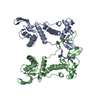 7pedC M: map data used to model this data C: citing same article ( |
|---|---|
| Similar structure data |
- Links
Links
- Assembly
Assembly
| Deposited unit | 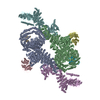
|
|---|---|
| 1 |
|
- Components
Components
| #1: Protein | Mass: 287484.156 Da / Num. of mol.: 2 Source method: isolated from a genetically manipulated source Source: (gene. exp.)  Homo sapiens (human) / Gene: MTOR, FRAP, FRAP1, FRAP2, RAFT1, RAPT1 / Production host: Homo sapiens (human) / Gene: MTOR, FRAP, FRAP1, FRAP2, RAFT1, RAPT1 / Production host:  References: UniProt: P42345, non-specific serine/threonine protein kinase |
|---|---|
| #2: Protein | Mass: 35910.090 Da / Num. of mol.: 2 Source method: isolated from a genetically manipulated source Source: (gene. exp.)  Homo sapiens (human) / Gene: MLST8, GBL, LST8 / Production host: Homo sapiens (human) / Gene: MLST8, GBL, LST8 / Production host:  |
| #3: Protein | Mass: 155963.094 Da / Num. of mol.: 2 Source method: isolated from a genetically manipulated source Source: (gene. exp.)  Homo sapiens (human) / Gene: RPTOR, KIAA1303, RAPTOR / Production host: Homo sapiens (human) / Gene: RPTOR, KIAA1303, RAPTOR / Production host:  |
| #4: Protein | Mass: 46365.832 Da / Num. of mol.: 2 Source method: isolated from a genetically manipulated source Source: (gene. exp.)  Homo sapiens (human) / Gene: DEPTOR, DEPDC6 / Production host: Homo sapiens (human) / Gene: DEPTOR, DEPDC6 / Production host:  |
| #5: Chemical | |
| Has ligand of interest | N |
-Experimental details
-Experiment
| Experiment | Method: ELECTRON MICROSCOPY |
|---|---|
| EM experiment | Aggregation state: PARTICLE / 3D reconstruction method: single particle reconstruction |
- Sample preparation
Sample preparation
| Component | Name: mTORC1 in complex with its regulator DEPTOR / Type: COMPLEX / Entity ID: #1-#4 / Source: RECOMBINANT | ||||||||||||||||||||||||||||||
|---|---|---|---|---|---|---|---|---|---|---|---|---|---|---|---|---|---|---|---|---|---|---|---|---|---|---|---|---|---|---|---|
| Molecular weight | Value: 1.04 MDa / Experimental value: NO | ||||||||||||||||||||||||||||||
| Source (natural) | Organism:  Homo sapiens (human) Homo sapiens (human) | ||||||||||||||||||||||||||||||
| Source (recombinant) | Organism:  | ||||||||||||||||||||||||||||||
| Buffer solution | pH: 7.5 | ||||||||||||||||||||||||||||||
| Buffer component |
| ||||||||||||||||||||||||||||||
| Specimen | Conc.: 1.4 mg/ml / Embedding applied: NO / Shadowing applied: NO / Staining applied: NO / Vitrification applied: YES | ||||||||||||||||||||||||||||||
| Vitrification | Cryogen name: ETHANE |
- Electron microscopy imaging
Electron microscopy imaging
| Microscopy | Model: TFS GLACIOS |
|---|---|
| Electron gun | Electron source:  FIELD EMISSION GUN / Accelerating voltage: 200 kV / Illumination mode: FLOOD BEAM FIELD EMISSION GUN / Accelerating voltage: 200 kV / Illumination mode: FLOOD BEAM |
| Electron lens | Mode: BRIGHT FIELD |
| Specimen holder | Cryogen: NITROGEN / Specimen holder model: FEI TITAN KRIOS AUTOGRID HOLDER |
| Image recording | Electron dose: 50 e/Å2 / Detector mode: COUNTING / Film or detector model: GATAN K3 (6k x 4k) |
- Processing
Processing
| Software | Name: PHENIX / Version: 1.19_4092: / Classification: refinement | ||||||||||||||||||||||||||||
|---|---|---|---|---|---|---|---|---|---|---|---|---|---|---|---|---|---|---|---|---|---|---|---|---|---|---|---|---|---|
| EM software |
| ||||||||||||||||||||||||||||
| CTF correction | Type: PHASE FLIPPING AND AMPLITUDE CORRECTION | ||||||||||||||||||||||||||||
| 3D reconstruction | Resolution: 4.07 Å / Resolution method: FSC 0.143 CUT-OFF / Num. of particles: 425076 / Symmetry type: POINT | ||||||||||||||||||||||||||||
| Atomic model building | PDB-ID: 6BCX Accession code: 6BCX / Source name: PDB / Type: experimental model | ||||||||||||||||||||||||||||
| Refine LS restraints |
|
 Movie
Movie Controller
Controller









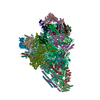


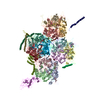

 PDBj
PDBj




